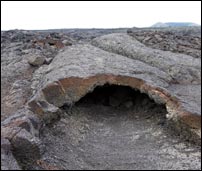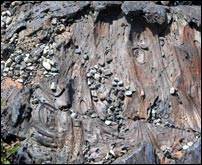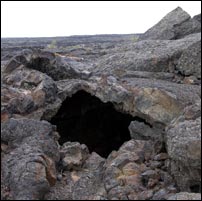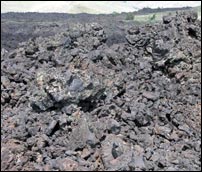Getting
Out There: |
Directory of all "Getting Out There" Articles> |
Craters of the Moon National Monument [Getting There]
by Mark Sedenquist
|
[Continued from Page 1]
Cinder Cones are characterized by a central volcanic vent with the accumulations of cinders (chunks of lava riddled with gas holes), volcanic bombs and splatter on the side of the cones. There are more than twenty-five large cinder cones in the park, and we walked up to a couple of them. There are four types of bombs in the park: spindle, ribbon, breadcrust, and cow-pie. They are all formed in the same way: globs of molten rock blast out of a vent or cinder cone. Their ultimate shape depends on their flight paths, how long they stayed in the air, and what they hit. Spindle bombs are twisted, and cow-pie bombs look exactly like what they're named after except some of them are over ten feet long.
Lava tubes are the hollow tunnels that form under the surface of lava flows and are shaped by the withdrawal of molten lava. Some of these are huge -- we walked through Indian Tunnel, which has a ceiling of forty feet and is 800 feet long. There are natural skylights, making the tunnel navigable without flashlights. Several other tubes in the area require hard hats, flashlights, and caving experience. The Caves Trail provides easy access to four of these lava tubes.
During some of the eruptions, chunks of volcano crater walls were carried like driftwood on the lava flows and these wall chunks are known as rafted blocks. The area around Devil's Orchard is full of these huge chunks of rock that floated away from the craters.
One of the most fascinating things about Craters of the Moon is seeing the different types of lava flows. Pahoehoe is generally very fluid and looks like "pulled taffy" in many places. It also forms stalactites of lava and is often called "ropy" lava. A'a, on the other hand, is very rough and sharp to the touch. The lava in the Blue Dragon flow has tiny titanian magnetite crystals suspended in the glassy surface and a range of colors, including bright blue, can be seen. "Even though they look really different, all forms of lava could come from the same volcano with the 'fresh, runny stuff' becoming pahoehoe and the 'older, crunchy' lava being formed as a'a," according to geologist and roadtripper Dan Sedenquist.
Since the most recent eruption was about 2,100 years ago, and the eruptions have occurred on a regular pattern every 2,000 years, it seems like Craters of the Moon just might be a very exciting road trip destination over the next few years.
|
GETTING THERE Satellite Image of the Lava field at the Craters of the Moon National Monument |
Mark Sedenquist
September 4, 2005
(Links updated December 29, 2021, RTA)




